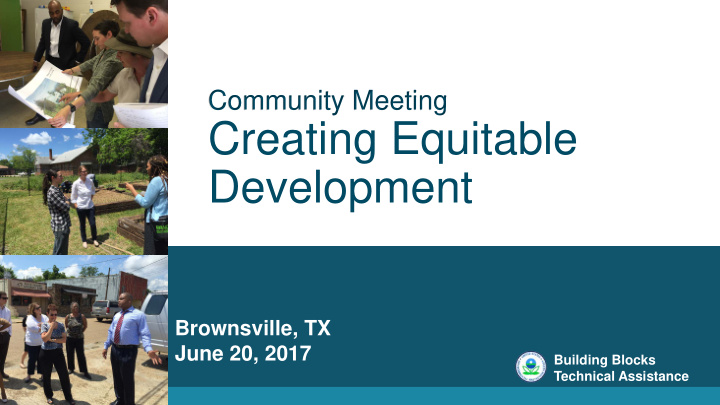



Community Meeting Creating Equitable Development Brownsville, TX June 20, 2017 Building Blocks Technical Assistance
Since 1996, EPA’s Office of Sustainable Communities has been helping communities grow in ways that expand economic opportunity, protect human health and the environment, and create and enhance the places that people love. Provide technical and planning assistance to communities Develop tools and publications to help communities achieve their goals for growth Working with federal, state, and local governments, non- profits, and the private sector to help implement strategies that meet community goals
Technical Assistance Includes… • Self-assessment Convene • Coordination calls to ID issues, confirm goals • Tailoring of materials • Documentation of • Identify attendees and • Community tour key issues, partners • Community meeting opportunities, priority • Technical workshop actions Assess Next Steps
Why Are We Here? Key Issues : • Successful Choice Neighborhoods effort • Participation and collaboration • Capacity building and community development infrastructure
What We’ll Cover This evening: • What is equitable development? • Examples of equitable development • Neighborhood assets and opportunities • Neighborhood planning Photo: Lawrence, MA Technical Assistance Workshop. Credit: Renaissance Planning
EQUITY AND EQUITABLE DEVELOPMENT
EQUITY: Fair access to livelihood, education, and resources; full participation in the political and cultural life of the community; and self-determination in meeting fundamental needs. I have access to all the benefits my community has to offer. Photo: Ephesus Elementary, Chapel Hill, NC. Credit: Alan Steinbeck
EQUITABLE DEVELOPMENT: Approaches for creating communities and regions where residents of all incomes, races, ages, and ethnicities participate in and benefit from decisions that shape the places where they live. I am involved in the process of shaping my community. Photo: Cleveland Avenue Homes, Winston-Salem, NC. Credit: Renaissance Planning
What does equitable development mean in your community? Photo: Equitable Development Neighborhood Tour in Kingston, NY. Credit: Renaissance Planning
EQUITABLE DEVELOPMENT IN YOUR COMMUNITY Trust Locals have power Affordable housing Accountable institutions Safe spaces for youth Housing and amenities for all types of families Stable local business district Reconnect the disenfranchised Opportunity for upward mobility Strong social capital
Common Types of Equitable Development Challenges Physical and Economic Generalized/Community-wide : Isolation: occurs when cities or widespread equity impacts; neighborhoods are cut off from often results from past injustices opportunities, by both physical and historical legacy barriers and perception barriers Gentrification/Neighborhood Public Projects/Decisions: Change : usually more localized these issues occur when one impacts; results from an influx neighborhood bears the brunt of the impacts resulting from major of more affluent residents, investment decisions like a displacing those who were highway, pipeline, or landfill already there
BUILDING CAPACITY How can gaps in capacity be overcome? • Wealthworks.org • Eight Capitals: “every region has a stock of each type of capital— the existing stocks of these capitals constitute a region’s current wealth.”
Stories from the Road: Selma, Alabama Equitable Development Building Blocks GOALS • Establish and support grassroots educational and workforce development programs • Support downtown health and redevelopment • Maintain existing communities and retain/attract small businesses • Build organizational and community capacity Photo: Selma residents during the Day 2 work session. Credit: Renaissance Planning
Stories from the Road: Macon Arts Alley • Participatory, arts-driven neighborhood development • Neighborhood stabilization through civic and housing investment • Arts programming oriented community Photo: Macon Arts Alley. Credit: Renaissance Planning
Stories from the Road: Renaissance Community Co-op (RCC) • The RCC is a 10,530-square foot, full service, community- owned cooperative grocery store • After five years of planning, and 18 years without a grocery store in northeast Greensboro, NC, the RCC celebrated its grand opening in November 2016 Photo: RCC founders celebrate the store’s soft opening. Credit: Renaissance Community Cooperative
Stories from the Road: Cleveland Avenue Neighborhood Choice Neighborhoods Transformation Plan • Community leadership • Asset Based Community Development • Resident-led initiatives • Participation in the design process Photo: Cleveland Avenue Neighborhood Transformation, Winston-Salem, NC. Credit: Renaissance Planning
Thank You for Joining Us
Recommend
More recommend